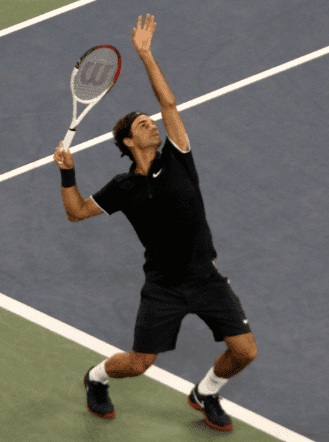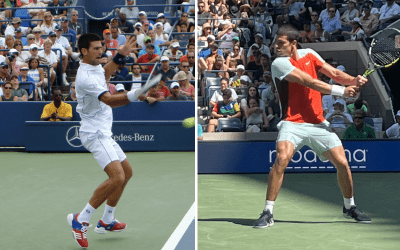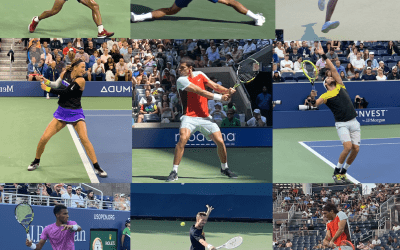Want a Killer Serve? Top Tips from a Real 4.5 Player (Guest Post)
The following is a guest post from Jim Olson – an avid 4.5 player from Madison, WI who I met earlier this year at Bollettieri IMG academy. Jim started playing at 13 years of age but became especially serious about the sport in 2001 while living in Little Rock, AR. There he learned of USTA league tennis and started out as a 3.5. He reached 4.5 in 2006. Tennis is his passion. Jim is a mechanical engineer with an MBA who is involved in various entrepreneurial projects. He’s also a great photographer and took the photos of Rafael Nadal and Roger Federer in this post. I invited Jim to share some insights about the most important factors that contributed to improving his serve through his own journey to reach NTRP 4.5 level tennis. Here’s what he wrote:
By Jim Olson
When I was a 3.5, I remember not liking my serve very much because it wasn’t a very big serve. I didn’t double fault much, but that’s because I barely put any pace on my second serve. That was OK at times, but I obviously suffered the consequences against the better players. My coach saw my lack of confidence and told me I needed to develop a “server’s mentality.” That is, when the match started, I should want to get that ball in my hands and serve; I should look forward to each of my service games and know that I have the serve to get the job done.
 I knew the only way to get to this state of mind was through lots (and lots) of practice. That summer, several times each week, I would take a basket of balls to the court and work on serves for 30 minutes at a time. I would do things like go for certain spots in the box, see how many serves out of 10 I could make, hit only first serves for a while, hit only second serves for a while, hit 1st and 2nd serve combos for a while…any little game that would get me hitting lots and lots of serves. I would work on every kind of serve to every spot in the box. The compound effect was that my serve improved, and my confidence improved: I knew my serve was better because I put in the time and witnessed it’s improvement. During a match, I would recall images from my serving practice and remember how much time I put in, and that gave me the confidence to go after it.
I knew the only way to get to this state of mind was through lots (and lots) of practice. That summer, several times each week, I would take a basket of balls to the court and work on serves for 30 minutes at a time. I would do things like go for certain spots in the box, see how many serves out of 10 I could make, hit only first serves for a while, hit only second serves for a while, hit 1st and 2nd serve combos for a while…any little game that would get me hitting lots and lots of serves. I would work on every kind of serve to every spot in the box. The compound effect was that my serve improved, and my confidence improved: I knew my serve was better because I put in the time and witnessed it’s improvement. During a match, I would recall images from my serving practice and remember how much time I put in, and that gave me the confidence to go after it.
My two biggest pieces of advice are:
1. Put in the time to work on your serve. Do what your opponents aren’t doing–head to the court two or three times a week with a basket of balls and put in 30 minutes of practice. Do this for a couple of months, and you’ll see a step-change improvement in your serve and your confidence. (Editor’s note: Click here for a video showing some good practice drills)
2. Think strong legs, loose arm. The serve is about the kinetic chain. Think of getting all of the power out of your legs and core, and let all of that power from those big muscles flow up (up!) into your extremely relaxed shoulder, arm, wrist, and hand.
Finally, a few words about a big change I made that has been vital to taking my serve to the next level such that it’s now a pretty decent 4.5 serve. When I was a 3.5/4.0, a pro pointed out that my left shoulder was dropping too much on the follow through after impact. I would land on my left foot and my body would be bent to the side as if my left shoulder wanted to continue to the ground. I wish I could illustrate the flaw to you and then the correction as I see it in my mind… but in my mind’s eye this is how the proper form basically looks and feels:
- Strong loading of the legs launches lots of energy upward.
- The abs are engaged and strong as if doing a crunch, helping to transfer the energy up.
- As that energy heads to the relaxed shoulder and arm, I think of an axis running through my head (quiet and still), neck, spine. As my relaxed shoulder and relaxed arm receive all of that energy, I loosely snap through the ball and my upper body rotates around that axis. It feels to me like the head/neck/spine is the primary axis while connecting with the ball, with my left leg the continuation of the axis as I drop back to earth.
- When that rotation happens properly, I can feel it. And I can feel my right leg naturally kicking up behind me as a counterbalance to both the rotational force and the forward momentum I can feel after hitting the ball. Take a look at the pros’ serves and you’ll see this kind of kick behind them as they land.
Oh, and a final thought about the all-important toss. I’ve certainly had my fair share of tossing problems. I think the toss comes down to a little experimentation and lots of practice (resulting in confidence), a very loose arm and relaxed hand.
- Think power from the ground up,
- transferred to a loose arm,
- while keeping the head still and allowing the shoulders and all of that energy to rotate about the head/neck/spine axis,
- and letting the right leg come up naturally behind as a counterbalance…
- Boom–big serve!
Video of Jim practicing serves
* Photo credits: Jim Olson, the author, took these photos of Rafael Nadal and Roger Federer
Feel Free to reach out to me directly at roadto45@gmail.com and be sure to follow me on social media!




[…] own stories about lessons learned on their own journeys to improve – just as fellow players Jim Olson and Jamie Powers did recently with great guest posts. Please consider that an invitation to send me […]